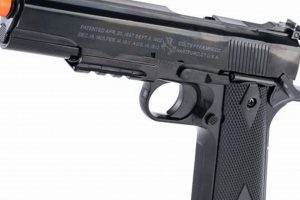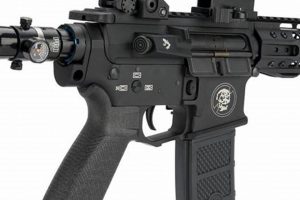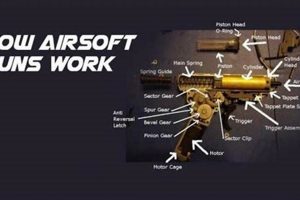The act of reducing the sound signature of an airsoft replica is a topic of interest for various reasons within the airsoft community. Certain modifications or additions can be made to mitigate the audible impact of the discharged projectile. This might involve integrating specific components designed to dampen sound waves created during operation, altering the overall acoustic profile of the device. As an example, incorporating foam-filled baffles within a mock suppressor unit can absorb sound energy, diminishing the report.
Minimizing the sound produced by an airsoft device offers advantages related to concealment and tactical gameplay. A quieter replica is less likely to betray a player’s position, especially during scenarios that necessitate stealth or ambushes. Historically, the desire for reduced noise signatures has mirrored developments in real-world firearms technology, with airsoft modifications often emulating similar principles. Benefits extend beyond gameplay, appealing to individuals who practice target shooting in noise-sensitive environments or those seeking a more realistic simulation experience.
Subsequently, examination into the components and methods utilized in sound reduction for airsoft replicas will provide a better understanding. Discussion will also include considerations regarding legality, proper installation techniques, and the potential impact on performance.
Sound Reduction Methods for Airsoft Replicas
Effective sound signature reduction for airsoft replicas requires careful consideration of component selection and installation techniques. The following tips offer guidance for achieving desired results.
Tip 1: Internal Barrel Foam: Inserting foam baffling within the inner barrel can dampen sound propagation. Ensure the foam density and fit do not impede projectile velocity or accuracy. Experimentation is required to find the optimal balance.
Tip 2: Mock Suppressor Integration: Utilize mock suppressors equipped with internal sound-dampening materials. These units are designed to attach to the barrel and diffuse sound waves as they exit the replica. Ensure proper alignment to prevent projectile strikes.
Tip 3: Gas System Optimization: For gas-powered replicas, adjust the gas output to minimize excess gas release. Overly high gas pressure can contribute to increased noise. Fine-tune the regulator or valve system as needed.
Tip 4: Material Dampening: Apply vibration-dampening materials to the outer shell of the replica, particularly in areas prone to resonance. This can reduce the overall acoustic signature by minimizing vibrations. Examples include specialized dampening tape or foam padding.
Tip 5: Spring Tension Adjustment: For spring-powered replicas, optimizing spring tension can influence noise levels. Excessively strong springs can create a louder impact sound. Experiment with spring guides and spacers to fine-tune performance.
Tip 6: Air Seal Enhancement: Ensuring a proper air seal throughout the replica’s internal components is crucial. Air leaks contribute to unnecessary noise. Implement O-ring replacements and proper lubrication to maintain a tight seal.
Successfully implementing these sound reduction techniques enhances concealment and tactical advantages during airsoft gameplay. Prioritize safety, legality, and replica functionality when making modifications.
Subsequent discussion will delve into the legality and potential drawbacks associated with these modifications.
1. Inner Barrel Foam
The strategic implementation of inner barrel foam is a method employed to attenuate the sound produced by airsoft replicas. Its relevance stems from the principle of absorbing and disrupting sound waves as they travel through the barrel after projectile expulsion.
- Foam Density and Composition
The effectiveness of inner barrel foam is directly correlated to its density and material composition. Higher density foams, often constructed from open-cell polyurethane or similar materials, offer greater sound absorption capabilities. However, excessive density can impede projectile velocity. Optimal foam selection balances sound attenuation with minimal performance degradation. For example, specialized acoustic foams designed for noise reduction are preferred over generic packaging materials.
- Foam Placement and Length
The placement and length of foam within the inner barrel influence its sound-dampening effect. Typically, foam segments are positioned strategically throughout the barrel, avoiding direct contact with the projectile’s path to prevent friction and accuracy issues. A common configuration involves multiple short segments of foam separated by air gaps. The overall length of foam used must be carefully calibrated to maximize sound reduction without significantly compromising projectile velocity or trajectory.
- Impact on Projectile Trajectory
A primary concern when utilizing inner barrel foam is its potential impact on projectile trajectory. Improperly installed or excessively dense foam can induce unwanted friction or turbulence, leading to inconsistent shot groupings and reduced effective range. Precision installation and regular inspection are vital to mitigating these adverse effects. Ensuring the foam is securely affixed and does not shift during operation is also essential for maintaining accuracy.
- Maintenance and Degradation
Inner barrel foam is subject to degradation over time due to repeated use and exposure to environmental factors such as moisture and temperature fluctuations. Regular inspection is necessary to identify signs of wear, such as crumbling, compression, or displacement. Degraded foam loses its sound-dampening properties and can potentially interfere with projectile trajectory. Periodic replacement of the foam is recommended to maintain consistent performance.
Integrating inner barrel foam into airsoft replicas presents a nuanced approach to sound signature reduction. While offering a degree of noise attenuation, careful consideration must be given to material selection, installation technique, and ongoing maintenance to ensure minimal impact on overall performance and accuracy. The success of this method hinges on achieving a delicate balance between sound suppression and maintaining the replica’s operational effectiveness.
2. Mock Suppressor Type
Mock suppressor type plays a significant role in attempts to reduce the auditory signature of an airsoft gun. While not functional suppressors in the ballistic sense, these devices, when properly designed, can alter and reduce the perceived loudness of the escaping gas and mechanical noises associated with operation. The internal construction of the mock suppressor directly influences its effectiveness. Models incorporating baffles, sound-dampening foam, or strategically placed chambers disrupt and absorb sound waves, reducing the report. Conversely, a simple, hollow tube offers negligible sound reduction benefits. The diameter, length, and internal materials contribute to overall performance. An example is a mock suppressor with multiple internal baffles designed to create turbulence, dissipating sound energy. A larger diameter generally allows for more sound-dampening material and larger baffles, increasing the potential for sound reduction.
Different types of mock suppressors utilize varying principles of sound wave manipulation. Baffled suppressors rely on deflecting and redirecting sound waves, causing them to collide and cancel each other out. Foam-filled suppressors absorb sound energy through the porous material. Some designs combine both methods for enhanced noise reduction. The choice of mock suppressor type hinges on the desired level of sound reduction, the physical constraints of the airsoft gun, and aesthetic considerations. The practical application of this knowledge allows players to select a mock suppressor that offers a balance between sound reduction and maintaining the replica’s performance characteristics. Incorrect installation or the use of ill-fitting suppressors can negatively impact accuracy or even damage the airsoft gun.
In summary, the mock suppressor type represents a critical element in altering the auditory profile of an airsoft gun. Understanding the principles behind different designs and the impact of internal construction allows informed selection based on individual needs and performance goals. While challenges exist in replicating true suppression, mock suppressors offer a tangible means to reduce the perceived sound signature, enhancing stealth and realism within the context of airsoft gameplay. This understanding links directly to the broader theme of modifying airsoft guns for specific performance characteristics.
3. Gas System Adjustment
Gas system adjustment constitutes a critical aspect of modifying gas-powered airsoft replicas to achieve a reduced auditory signature. The operational principle centers on regulating the quantity of gas released during each firing cycle. Excessive gas discharge generates increased noise, stemming from the rapid expansion and release of pressurized gas into the atmosphere. By carefully calibrating the gas valve or regulator, it is possible to minimize the volume of escaping gas, thereby lessening the overall sound produced. For instance, in gas blowback pistols, adjusting the valve to release only the amount of gas necessary to propel the projectile and cycle the slide significantly lowers the report compared to a system operating at maximum pressure. This modulation is a direct causal factor in sound reduction.
The importance of proper gas system adjustment extends beyond simple noise mitigation. Efficient gas usage also enhances operational efficiency, increasing the number of shots obtainable per gas charge. Real-world examples of this principle are evident in high-end gas-powered airsoft rifles equipped with adjustable regulators, allowing users to fine-tune performance for various scenarios. Over-pressurizing the system not only increases noise but also accelerates wear and tear on internal components. Conversely, under-pressurizing can lead to inconsistent performance and reduced projectile velocity. Precision adjustment therefore necessitates specialized tools such as chronographs to measure projectile velocity and gas gauges to monitor pressure levels. The practical significance of this understanding lies in optimizing both sound signature and replica longevity.
In conclusion, gas system adjustment plays a pivotal role in noise reduction efforts concerning gas-powered airsoft replicas. Carefully controlling gas output minimizes unnecessary noise, improves operational efficiency, and enhances replica longevity. The inherent challenge lies in achieving a balance between sound suppression and maintaining optimal performance characteristics. This understanding links directly to the broader theme of modifying airsoft guns, where informed adjustments contribute to a more effective and stealthy operational profile.
4. Material Vibration Dampening
Material vibration dampening, in the context of reducing the auditory signature of an airsoft gun, involves employing materials to minimize the transmission and amplification of mechanical vibrations generated during operation. These vibrations contribute significantly to the overall noise produced, and their mitigation forms an integral part of sound reduction strategies.
- Material Selection and Placement
The choice of damping material and its strategic placement are critical. Materials with high damping coefficients, such as viscoelastic polymers or specialized damping tapes, are preferred. These materials absorb vibrational energy, converting it into heat. Placement focuses on areas prone to significant vibration, including the receiver, outer barrel, and stock. For instance, applying damping tape to the exterior of a metal receiver can reduce resonance and diminish the perceived sound level. Selection depends on temperature stability, adhesion properties, and compatibility with the replica’s materials.
- Mechanism of Damping
Vibration damping relies on the principle of energy dissipation. When a vibrating component is constrained by a damping material, the material deforms, converting mechanical energy into thermal energy. This process reduces the amplitude and duration of the vibrations, resulting in a quieter replica. An example is the use of constrained layer damping, where a damping material is sandwiched between two rigid layers. The shear deformation of the damping material under vibration effectively dissipates energy. This mechanism directly diminishes the noise produced by vibrating components.
- Impact on Sound Frequency Profile
Damping materials not only reduce overall noise levels but also alter the frequency profile of the sound produced. By selectively damping certain frequencies, the perceived sound can become less sharp or piercing. For example, damping materials can be chosen to target high-frequency vibrations, which are often more noticeable and contribute significantly to the perceived harshness of the sound. This targeted approach can result in a more muffled and less detectable sound signature. Understanding the frequency profile of the vibrations allows for the selection of optimal damping materials.
- Integration with Other Noise Reduction Methods
Material vibration damping is most effective when integrated with other noise reduction techniques, such as inner barrel foam or mock suppressors. Damping reduces the initial vibration, while other methods further attenuate the resulting sound waves. A comprehensive approach combining multiple strategies yields the greatest reduction in auditory signature. For instance, applying damping materials to the receiver and then attaching a foam-filled mock suppressor can achieve a substantial reduction in overall noise compared to using either method alone. This synergistic effect enhances the overall effectiveness of sound reduction efforts.
The application of material vibration damping represents a significant component in mitigating the sound generated by airsoft guns. Careful material selection, strategic placement, and integration with other noise reduction methods contribute to a more discreet operational profile, benefiting users seeking enhanced stealth and realism during gameplay.
5. Spring Tension Optimizing
Spring tension optimization, pertaining to spring-powered airsoft guns, presents a nuanced approach to sound signature reduction. Its relevance stems from the principle that excessive or improperly calibrated spring tension contributes to increased mechanical noise during operation. Achieving optimal spring tension minimizes unnecessary vibrations and impact forces, directly influencing the audible output of the replica.
- Spring Strength and Impact Noise
The strength of the mainspring directly correlates with the force exerted on the piston and, consequently, the impact generated upon reaching the cylinder head. Overly strong springs produce a louder, more abrupt impact sound. Implementing a spring that is precisely matched to the desired projectile velocity reduces this impact force, resulting in a diminished auditory signature. Examples include using a weaker spring coupled with a tight air seal to achieve the same velocity as a stronger spring with air leaks, but with significantly less noise.
- Spring Guide and Vibration Dampening
The spring guide plays a critical role in minimizing spring oscillations during compression and release. A poorly designed or worn spring guide allows the spring to vibrate excessively, contributing to audible noise. Upgrading to a spring guide with bearings or incorporating dampening materials within the guide can reduce these vibrations. For instance, a spring guide with ball bearings allows the spring to rotate smoothly during compression, preventing binding and reducing friction-induced noise. Similarly, a spring guide made of a vibration-dampening polymer can absorb vibrational energy, further minimizing noise.
- Piston Head Dampening
The piston head, being the direct point of impact against the cylinder head, is a significant source of noise. Incorporating a piston head with dampening properties mitigates this impact noise. Examples include piston heads with rubber or polymer padding designed to absorb impact energy. These padded piston heads reduce the intensity of the impact, resulting in a quieter report. The choice of material and design of the piston head significantly influences the effectiveness of this dampening effect.
- Air Volume Matching
Optimizing the air volume within the cylinder to match the barrel length and projectile weight is crucial for efficiency and noise reduction. Excess air volume creates overpressure, leading to a louder report. By selecting a cylinder with an appropriate volume, the amount of air expelled during each cycle is minimized, reducing unnecessary noise. An example is using a ported cylinder to reduce the air volume for shorter inner barrels, preventing overpressure and the associated noise.
In conclusion, spring tension optimization constitutes a multifaceted approach to reducing the sound signature of spring-powered airsoft guns. By carefully selecting spring strength, upgrading the spring guide, incorporating piston head dampening, and matching air volume, significant reductions in mechanical noise can be achieved. This interconnectedness highlights the importance of considering the entire system when striving for noise reduction in airsoft replicas.
6. Air Seal Integrity
Air seal integrity represents a fundamental component in reducing the auditory signature of airsoft replicas. A compromised air seal allows pressurized air to escape from various points within the system, creating unwanted noise and reducing efficiency. Eliminating these air leaks minimizes the sharp, hissing sounds generated by escaping air, contributing significantly to overall sound reduction. An example is a gas blowback pistol where leaks around the magazine valve or nozzle create distinct hissing noises upon firing. Achieving a tight seal, conversely, channels the pressurized air more efficiently, reducing extraneous noise and maximizing projectile velocity. The relationship is causal: improved air seal integrity directly leads to a quieter replica.
Proper maintenance and component selection are crucial for maintaining optimal air seal integrity. Replacing worn O-rings, applying silicone grease to sealing surfaces, and ensuring correct alignment of internal components are essential practices. For instance, in airsoft gearboxes, a leaky piston head O-ring can drastically reduce performance and increase noise. Replacing the O-ring with a high-quality, correctly sized component restores air seal integrity, leading to both a quieter operation and improved power output. This principle applies across various airsoft replica types, from gas-powered pistols to spring-powered rifles. Implementing these maintenance procedures directly contributes to achieving the desired effect, reducing unnecessary noise associated with airsoft replica operation.
In summary, air seal integrity forms a critical link in minimizing the sound produced by airsoft replicas. Preventing air leaks reduces unwanted noise, improves operational efficiency, and enhances overall performance. The challenges associated with maintaining a perfect air seal highlight the importance of meticulous maintenance and careful component selection. The practical significance of understanding this relationship lies in achieving a more effective and discreet operational profile, aligning with the broader theme of modifying airsoft guns for enhanced performance and realism.
Frequently Asked Questions
The following addresses commonly encountered questions regarding methods to diminish the auditory signature of airsoft replicas.
Question 1: What constitutes “suppression” in the context of airsoft replicas?
Unlike firearms, achieving true sound suppression is not possible with airsoft replicas. The term, in this context, refers to reducing the perceived loudness of the replica’s operation through various modifications and additions.
Question 2: Is it legal to modify an airsoft replica to reduce its sound signature?
Legality varies depending on jurisdiction. It is imperative to consult local laws and regulations regarding modifications to airsoft replicas before implementing any sound reduction measures. Some regions may have restrictions on altering the appearance or function of airsoft devices.
Question 3: Do mock suppressors effectively eliminate the sound produced by airsoft replicas?
Mock suppressors do not eliminate sound entirely. They alter the sound signature, typically reducing the perceived loudness and changing the tone. The effectiveness depends on the design and internal construction of the mock suppressor.
Question 4: Will reducing the sound signature of an airsoft replica affect its performance?
Certain modifications, particularly those involving internal components, can potentially impact performance. Improper installation or unsuitable materials may reduce projectile velocity or accuracy. Careful consideration and proper installation techniques are essential to minimize performance degradation.
Question 5: What are the primary sources of sound produced by airsoft replicas?
The primary sound sources include the release of pressurized gas (in gas-powered replicas), the impact of internal components (such as the piston against the cylinder head), and vibrations of the replica’s outer shell.
Question 6: Is specialized knowledge required to implement sound reduction modifications on airsoft replicas?
While some modifications are relatively straightforward, others require a degree of technical understanding. It is recommended to consult with experienced airsoft technicians or refer to detailed guides before attempting complex modifications.
The information provided herein serves as a general overview. Individuals are responsible for ensuring compliance with all applicable laws and regulations regarding airsoft replica modifications.
Subsequently, a summary of best practices for maintaining a sound-reduced airsoft replica will be provided.
Concluding Thoughts on Sound Signature Reduction in Airsoft Replicas
This exploration has detailed various methods for mitigating the auditory signature of airsoft guns. Approaches range from internal component modifications, such as inner barrel foam and spring tension optimization, to external additions like mock suppressors and vibration-dampening materials. Each technique aims to reduce the perceived loudness of operation. Achieving a balance between sound reduction and maintaining operational efficacy is emphasized.
The pursuit of a quieter airsoft replica remains a continuous endeavor, requiring a nuanced understanding of mechanics, acoustics, and legal implications. Users are strongly encouraged to prioritize safe practices and adherence to local regulations when implementing any modifications. The responsibility for any alterations rests solely with the individual practitioner.


![Guide: What Is The Best Airsoft Gun to Buy? [2024] Ultimate Airsoft Guide for Beginners, Tactics & Gear Reviews Guide: What Is The Best Airsoft Gun to Buy? [2024] | Ultimate Airsoft Guide for Beginners, Tactics & Gear Reviews](https://airsoftica.com/wp-content/uploads/2025/12/th-653-300x200.jpg)




